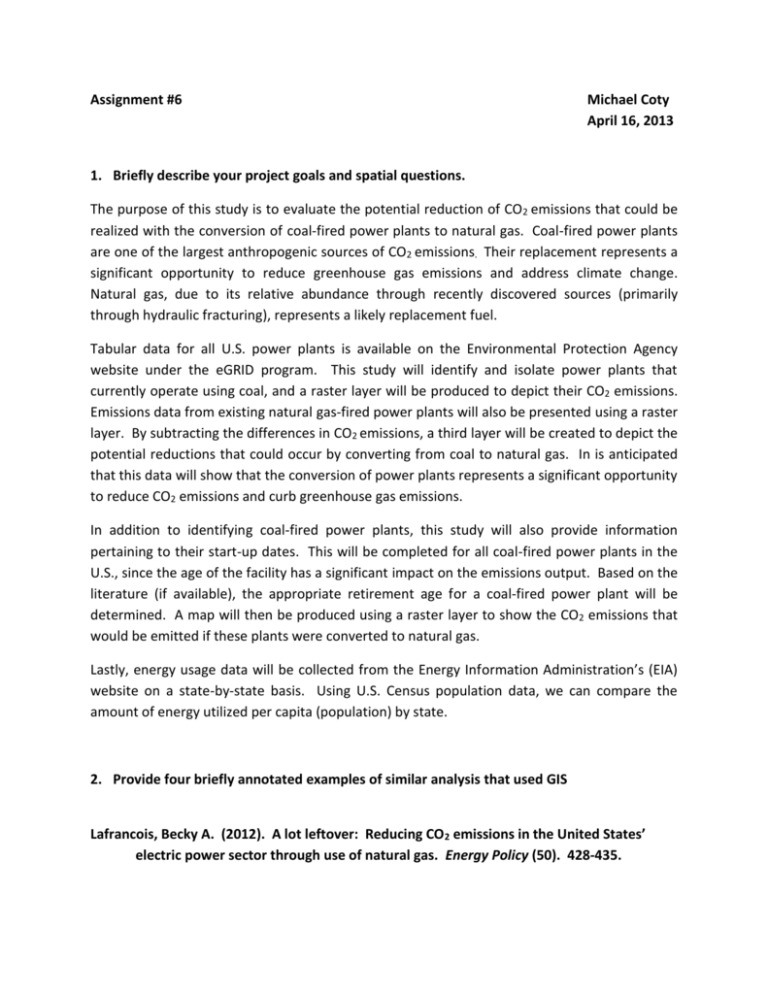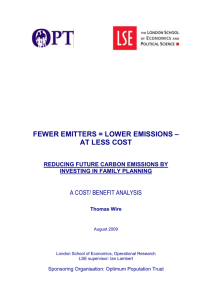Assignment 6 - Michael Coty
advertisement

Assignment #6 Michael Coty April 16, 2013 1. Briefly describe your project goals and spatial questions. The purpose of this study is to evaluate the potential reduction of CO 2 emissions that could be realized with the conversion of coal-fired power plants to natural gas. Coal-fired power plants are one of the largest anthropogenic sources of CO2 emissions. Their replacement represents a significant opportunity to reduce greenhouse gas emissions and address climate change. Natural gas, due to its relative abundance through recently discovered sources (primarily through hydraulic fracturing), represents a likely replacement fuel. Tabular data for all U.S. power plants is available on the Environmental Protection Agency website under the eGRID program. This study will identify and isolate power plants that currently operate using coal, and a raster layer will be produced to depict their CO2 emissions. Emissions data from existing natural gas-fired power plants will also be presented using a raster layer. By subtracting the differences in CO2 emissions, a third layer will be created to depict the potential reductions that could occur by converting from coal to natural gas. In is anticipated that this data will show that the conversion of power plants represents a significant opportunity to reduce CO2 emissions and curb greenhouse gas emissions. In addition to identifying coal-fired power plants, this study will also provide information pertaining to their start-up dates. This will be completed for all coal-fired power plants in the U.S., since the age of the facility has a significant impact on the emissions output. Based on the literature (if available), the appropriate retirement age for a coal-fired power plant will be determined. A map will then be produced using a raster layer to show the CO2 emissions that would be emitted if these plants were converted to natural gas. Lastly, energy usage data will be collected from the Energy Information Administration’s (EIA) website on a state-by-state basis. Using U.S. Census population data, we can compare the amount of energy utilized per capita (population) by state. 2. Provide four briefly annotated examples of similar analysis that used GIS Lafrancois, Becky A. (2012). A lot leftover: Reducing CO 2 emissions in the United States’ electric power sector through use of natural gas. Energy Policy (50). 428-435. This article begins with a description of the importance of power plants in reducing greenhouse gas emissions. In fact, the author describes electricity generation as the primary source of CO2 emissions in the U.S. Different fossil fuels have different combustion properties. In addition, there are numerous technologies available to process and use fossil fuels. For example, the author suggests there are significant gains in CO2 emissions reduction that can be realized from converting power plants from coal to natural gas. The author estimates that the conversion could reduce CO2 emissions by 59% per gigawatt-year of electricity. This article does not provide GIS-related data, but appears to be a critical article for providing background information related to the utilization of natural gas for electricity generation. Zhou, Yuyu and Gurney, Kevin Robert. (2011). Spatial Relationships of Sector-Specific Fossilfuel CO2 Emissions in the USA. Global Biogeochemical Cycles (25). 1-43. Accessed online 4/14/13. http://vulcan.project.asu.edu/pdf/Zhou.Gurney.GBC.inpress.2011.pdf This article was accessed on the Vulcan Project website and provides detailed analysis of mapping CO2 emissions for different sectors across the U.S. The article provides spatial analysis of emissions at the state and county levels. The article quantifies CO2 emissions from the transportation, residential, commercial, industrial and electricity-producing sectors. For this analysis, we are concerned with the information related to the electricity production. The article discusses the importance of considering total versus per capita patterns and conveys the differences by energy sector. In addition, the article emphasizes policies for reducing CO2 emissions based on geography and by targeting specific sectors. Gurney, Kevin R., Mendoza, Daniel L., Zhou, Yuyu, Fischer, Marc L., Miller, Chris C., Geethakumar, Sarath and De La Rue Du Can, Stephane (2009). High Resolution Fossil Fuel Combustion CO2 Emission Fluxes for the United States. Environmental Science and Technology. 1-7 Accessed online 4/14/13 http://vulcan.project.asu.edu/pdf/Gurney.EST.2009.pdf This paper was also provided on the Vulcan Project website and discusses detailed information regarding their methods of mapping CO2 emissions data. It is beneficial to review this information in terms of where and how they collect their data, and how they choose to present the information. For example, the data appears to be most often presented using a 10 km x 10 km grid on a raster layer. Also, data utilized by the Vulcan Project from the electricity sector is collected primarily through Emissions Tracking Systems/Continuous Emissions Monitoring Systems (ETS/CEM). These types of systems produce the most accurate emissions data from power plants. Gabrielle Petron, Pieter Tans, Gregory Frost, Danlei Chao, and Michael Trainer. (2008). High-resolution emissions of CO2 from power generation in the USA. Journal of Geophysical Research. (113) G04008. 1-9. This article provides useful background information on the collection and distribution of CO2 emissions data. This includes information provided by the EPA and the Department of Energy’s Energy Information Agency (EIA). Power plants that utilize fossil fuels and emit CO 2 above a certain level are required to report this data to the EPA. The EIA’s Annual Energy Outlook report is also a good source of information regarding future predictions of CO2 emissions. 3. List of Data and Tabular Layers: GIS Layer/Tabular Data Source Key Attributes States ESRI Data Map 10 Lower 48 States Power Plants (2009) U.S. EPA eGRID Plants by Fuel Source CO2 Emissions (tons) Date of Plant On-line Population U.S. Census Population by State Energy Usage Energy Information Administration Electricity Use by State 4. Data Processing and Analysis: 1. Project the U.S. ESRI Data Map into the U.S. National Atlas Equal Area system. 2. Utilize the “Select by Attributes” tool to select the lower 48 states only (not including Alaska and Hawaii). 3. Import the eGRID tabular data from the U.S. EPA website. This data contains latitude and longitude coordinates, as well as emissions data, for every power plant in the U.S. 4. Join the eGRID data to the U.S. states polygon map. 5. Utilize the “Display XY Data” tool to place the power plant locations on the U.S. states map and generate shape file. 6. Use the “Select by Attributes” tool to select coal-fired power plants and generate shape file. 7. Create a map of the lower 48 states that displays the coal-fired power plants and the date the facility went on-line. This information is available on the eGRID excel table under the “BLR09” tab. Based on the literature (if available) and the age of the plant, determine which facilities should be retired. Provide map with raster layer to estimate CO2 emissions if these plants were removed from service and converted to natural gas. 8. Use the “Select by Attributes” tool to select natural gas-fired power plants and generate shape file. 9. Use the kernel density tool to create a raster layer and display the annual CO2 emissions (tons) for coal-fired power plants using a graduated color scheme. 10. Use the kernel density tool to create a raster layer and display the annual CO2 emissions (tons) for gas-fired power plants using a graduated color scheme. 11. Produce a layer depicting the differences in quantities of annual CO2 emissions rates for coaland gas-fired power plants using a graduated color scheme. The goal of this step will be to present a map illustrating the reduction in CO2 emissions that can be realized from converting coal plants to natural gas. 12. Produce map showing the age of coal-fired power plants. 13. Create raster layer to show reductions in CO2 emissions from converting older coal-fired power plants to natural gas. 14. Collect energy usage tabular data from EIA’s website by state. 15. Join table to U.S. states polygon map. 16. Calculate energy usage per capita (population) and display as polygon map to show energy intensity by state. 5. Products to Include on Poster: Map of lower 48 states of the U.S. depicting the location of all power plants. Summarize the type of power plants by state and fuel source (i.e., coal, natural gas, nuclear). This will most likely be completed using a pie chart. Map of lower 48 states depicting the location of all coal-fired power plants. Map of lower 48 states showing CO2 emissions from coal-fired power plants. Map of lower 48 states depicting the location of all gas-fired power plants. Map of lower 48 states showing CO2 emissions from gas-fired power plants. Map of lower 48 states showing differences in CO2 emissions between the two types of plants, depending on the fuel source utilized. Map showing the age of coal-fired power plants with a recommendation for retirement of older plants. Map depicting the difference in CO2 emissions if these power plants were converted to natural gas. Photograph of converted power plant (if available). References









